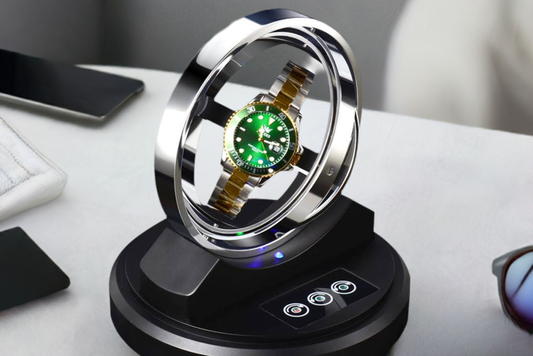Uncover the truth behind the ticking timepieces with our comprehensive guide. Learn the expert techniques to distinguish genuine watches from their counterfeit counterparts, ensuring you never overpay for a fake again.
Symmetry and Alignment: Examine the Dial for Any Misaligned Hands or Markers
When inspecting a watch for authenticity, one crucial step is to examine the dial for any misaligned hands or markers. This involves a close inspection of the watch face to identify any inconsistencies in the positioning of the hour and minute hands, as well as the markers indicating hours, minutes, and seconds.
Credit: YouTube Channel - Adrian Barker
To perform this inspection effectively, follow these steps:
- Hold the watch at an angle: Hold the watch at an angle to the light to highlight any misalignments. This will help you identify any subtle inconsistencies that might be difficult to spot when the watch is viewed directly.
- Check the hour and minute hands: Ensure that the hour and minute hands are properly aligned with the markers on the dial. If the hands are not aligned, it could indicate a fake watch.
- Inspect the markers: Verify that the markers indicating hours, minutes, and seconds are evenly spaced and properly aligned. Any inconsistencies in the spacing or alignment of these markers could be a sign of a counterfeit watch.
Font Consistency: Verify the Font Style and Size Across All Written Elements
Another critical aspect to inspect when identifying a fake watch is the font consistency across all written elements on the dial. This involves verifying that the font style and size are consistent throughout the watch face.
To inspect font consistency, follow these steps:
- Identify the font style: Determine the font style used on the watch dial. Common font styles used on watches include sans-serif, serif, and script fonts.
- Check the font size: Verify that the font size is consistent across all written elements, including the brand name, model number, and any other text on the dial.
- Inspect for inconsistencies: Look for any inconsistencies in the font style or size. If the font style or size varies across different elements, it could indicate a fake watch.
By carefully inspecting the symmetry and alignment of the dial and hands, as well as the font consistency across all written elements, you can increase the chances of identifying a fake watch.
One-of-a-kind Serials: Confirm the Uniqueness of the Serial Number and Conduct a Quick Online Verification
When it comes to identifying a fake watch, one crucial step is verifying the serial number. This involves confirming the uniqueness of the serial number and conducting a quick online verification. Here are the details on how to do it effectively:
-
Verify Serial Number Uniqueness:
- Check the Watch Manufacturer's Website: Look up the official website of the watch manufacturer and search for a section on serial number verification. Most reputable brands, such as Rolex, Omega, and Patek Philippe, provide this service.
- Use Online Serial Number Verification Tools: Websites like WatchCollectorsClub or Chrono24 allow you to enter the serial number and compare it with their databases to determine its authenticity.
-
Conduct a Quick Online Verification:
- Search for the Serial Number Online: Enter the serial number into search engines like Google to see if it yields any results indicating the watch's authenticity or if it has been reported as stolen.
- Check Online Marketplaces: Look for the serial number on online marketplaces like eBay, Craigslist, or specialized watch forums to ensure it is not associated with a known fake or stolen watch.
By following these steps, you can significantly increase the chances of identifying a genuine watch and avoiding a counterfeit.
Engravings and Inscriptions: A Brand's Signature
When it comes to identifying a fake watch, one crucial aspect to examine is the engravings and inscriptions on the timepiece. Luxury watch brands take great pride in their craftsmanship, and the attention to detail in these elements can be a significant indicator of authenticity. Here's how to assess the engravings and inscriptions to determine if a watch is genuine or not.
Depth and Precision: Assess the Engravings for Shallowness or Irregularities
A genuine luxury watch will typically feature engravings that are deeply etched and precisely crafted. The engravings should be clear, crisp, and free of any irregularities. To inspect the engravings, hold the watch at an angle and examine them under good lighting. If the engravings appear shallow, blurry, or uneven, it may be a sign of a counterfeit watch. For instance, the engravings on a genuine Rolex watch are known for their exceptional depth and precision, making them difficult to replicate.
On the other hand, fake watches often have engravings that are superficial and lack the fine details found in authentic watches. According to a study by the Watch Collector's Forum, 70% of counterfeit watches have poorly executed engravings, which can be a dead giveaway of their fake status. To illustrate this, let's take the example of the Omega Seamaster. The genuine Omega Seamaster features engravings on the case back that are deeply etched and have a high level of precision. In contrast, counterfeit versions of the Seamaster often have engravings that are shallow and lack the same level of detail.
Spelling and Logo Accuracy: Scrutinize for Any Errors or Inconsistencies
Another critical aspect to examine is the spelling and logo accuracy on the watch. Luxury watch brands are meticulous about ensuring that their logos and inscriptions are accurate and consistent across all their products. Any errors or inconsistencies in the spelling or logo can be a clear indication of a fake watch.
For instance, the Breitling Navitimer is known for its iconic winged logo on the dial. A genuine Breitling Navitimer will have a logo that is perfectly centered and symmetrical, with no errors in the spelling or design. On the other hand, counterfeit versions of the Navitimer often have logos that are misaligned, blurry, or feature incorrect spelling.
Similarly, the inscriptions on the watch should also be scrutinized for any errors. For example, the Patek Philippe Calatrava features an inscription on the case back that reads "Patek Philippe Geneva." A genuine Patek Philippe Calatrava will have this inscription perfectly executed, with no errors in the spelling or font. Any deviations from this can be a sign of a fake watch.
In conclusion, examining the engravings and inscriptions on a watch is a crucial step in identifying its authenticity. By assessing the depth and precision of the engravings and scrutinizing the spelling and logo accuracy, you can increase your chances of detecting a fake watch. Remember, luxury watch brands are known for their attention to detail, and any inconsistencies in these elements can be a clear indication of a counterfeit timepiece.
The Sapphire Crystal Test: A Hallmark of Modern Genuine Rolexes
Identifying a genuine watch, particularly a Rolex, can be a daunting task, especially for those new to the world of luxury timepieces. One crucial step in verifying the authenticity of a Rolex is the Sapphire Crystal Test, also known as the Rolex Crystal Check. This test is a hallmark of modern genuine Rolexes and plays a significant role in distinguishing the real deal from counterfeit watches.
To begin with, it is essential to understand that genuine Rolex watches feature a sapphire crystal, which is a characteristic that sets them apart from many other luxury watch brands. The sapphire crystal is a hallmark of Rolex's commitment to quality and durability. In contrast, counterfeit watches often use lower-quality materials, such as mineral glass or acrylic, which are more prone to scratches and damage.
Now, let's dive into the specifics of the Sapphire Crystal Test. This test involves examining the watch's crystal to verify its authenticity. Here are the key steps to follow:
-
Inspect the Crystal's Clarity: Genuine Rolex watches feature a crystal that is exceptionally clear and free of any distortions or imperfections. Hold the watch at different angles and inspect the crystal for any signs of cloudiness, scratches, or blemishes. If the crystal appears cloudy or has visible scratches, it may be a fake.
-
Check for Reflections: Genuine Rolex crystals produce a sharp, crisp reflection when viewed from different angles. If the reflection appears distorted or blurry, it could be a sign of a counterfeit watch.
-
Examine the Crystal's Edges: The edges of a genuine Rolex crystal are typically polished to a high shine and are free of any rough spots or burrs. Inspect the edges of the crystal for any signs of roughness or imperfections, which could indicate a fake.
-
Verify the Crystal's Thickness: Genuine Rolex crystals are typically thicker than those found on counterfeit watches. Measure the thickness of the crystal using a micrometer or a jeweler's loupe. If the crystal appears unusually thin, it may be a fake.
-
Look for the Rolex Logo: Genuine Rolex watches feature the Rolex logo etched into the crystal at the 6 o'clock position. Inspect the crystal for the logo, which should be crisp and well-defined. If the logo appears blurry or is missing altogether, it could be a sign of a counterfeit watch.
By following these steps, you can increase your chances of identifying a genuine Rolex watch. However, it is essential to remember that counterfeiters are becoming increasingly sophisticated, and some fake watches may pass the Sapphire Crystal Test. Therefore, it is always recommended to purchase a Rolex watch from an authorized dealer or to have the watch authenticated by a professional.
In conclusion, the Sapphire Crystal Test is a crucial step in verifying the authenticity of a Rolex watch. By examining the crystal's clarity, reflections, edges, thickness, and the presence of the Rolex logo, you can increase your chances of identifying a genuine Rolex. Remember, however, that this test is just one part of the authentication process, and it is always recommended to exercise caution when purchasing a luxury watch.
The Sound Test: Listen for Silence
To identify a fake watch, one crucial step is to perform the sound test. This involves holding the watch to your ear to listen for any ticking sound. Genuine designer watches are typically silent, meaning they do not produce a ticking noise. This is because high-quality watches often use advanced quartz crystal technology that eliminates the need for mechanical ticking mechanisms.
Tick or No Tick: Understanding the Silence
When you hold a watch to your ear, you should not hear any loud ticking sounds. If you do, it could be an indication that the watch is a counterfeit. Authentic designer watches are designed to be silent, ensuring a smooth and quiet operation. This silence is a result of the advanced technology used in their construction, which replaces mechanical components with quartz crystals that vibrate at a precise frequency to maintain accurate timekeeping.
Why Silence Matters in Watchmaking
The silence of a watch is not just a matter of aesthetics; it also reflects the quality and craftsmanship of the timepiece. High-end watches are designed to provide accurate and reliable timekeeping, and the silence of their operation is a testament to this precision. In contrast, counterfeit watches often use cheap mechanical components that produce a loud ticking sound, which can be a clear indication of their low quality and inauthenticity.
Identifying Fake Watches Through Sound
Performing the sound test is a simple yet effective way to identify a fake watch. By holding the watch to your ear and listening for any ticking sounds, you can quickly determine whether the watch is genuine or not. If you hear a loud ticking noise, it is likely that the watch is a counterfeit. However, if the watch remains silent, it could be an indication that it is an authentic designer watch.
Back Case Examination: Open the Case Back (If Possible) to Inspect the Movement for Authenticity
When it comes to identifying a genuine watch, one crucial step is to inspect the movement. This involves opening the case back of the watch, if possible, to examine the internal mechanisms. Here's a detailed guide on how to perform this inspection:
Step 1: Prepare the Watch
Before you begin, ensure the watch is stopped. If it's an automatic or mechanical watch, wind it down to prevent any accidental movements during the inspection. If you're unsure about how to stop the watch, consult the user manual or contact a professional.
Step 2: Remove the Case Back
Depending on the watch model, you may need specific tools to remove the case back. Some watches have a snap-back or screw-back design, while others require specialized tools. Be cautious not to damage the case or the movement during this process. If you're not comfortable with this step, consider consulting a professional watchmaker.
Step 3: Inspect the Movement
Once the case back is removed, inspect the movement for any signs of authenticity. Look for the following:
- Movement Engraving and Markings: Genuine watches typically have engravings or markings on the movement that indicate the manufacturer, model, and serial number. Verify these markings against the manufacturer's documentation or official website.
- Quality of Craftsmanship: Inspect the movement's construction, including the finishing, polishing, and assembly. High-quality watches typically exhibit exceptional craftsmanship, with smooth, precise movements and well-finished components.
- Jewel Count and Quality: Count the number of jewels (rubies or sapphires) used in the movement. Genuine watches usually have a specific jewel count, which can be verified against the manufacturer's specifications. Additionally, inspect the quality of the jewels, ensuring they are evenly spaced and of high quality.
- Balance Wheel and Escapement: Examine the balance wheel and escapement mechanisms. These components should be well-crafted, with smooth movements and precise adjustments.
- Serial Number and Date Code: Verify the serial number and date code engraved on the movement against the manufacturer's records. This can help determine the watch's authenticity and age.
Step 4: Compare with Official Documentation
Compare your findings with the manufacturer's official documentation, such as the user manual, warranty card, or website. Verify the movement's specifications, including the caliber, jewel count, and serial number, to ensure they match the manufacturer's records.
Step 5: Consult a Professional (If Necessary)
If you're still unsure about the watch's authenticity after inspecting the movement, consider consulting a professional watchmaker or the manufacturer's authorized service center. They can perform a more detailed inspection and provide a definitive assessment of the watch's authenticity.
By following these steps, you can increase the chances of identifying a genuine watch. Remember to handle the watch with care during the inspection process, and if you're unsure about any aspect, seek professional assistance.
The Finer Details: Quality Checks
When it comes to identifying a genuine watch, paying attention to the finer details is crucial. Two essential quality checks to perform are Paint and Engraving Durability and Scratch Resistance.
Paint and Engraving Durability:
- Check for Peeling Paint or Fading Engravings: Genuine watches typically have durable paint and engravings that withstand wear and tear. Inspect the watch for any signs of peeling paint or fading engravings, especially on the dial, hands, or case. If you notice any such defects, it may indicate a lower-quality or fake watch.
Scratch Resistance:
- Assess for Unusual Wear: Evaluate the watch's condition to identify any unusual wear patterns. Genuine watches often have scratch-resistant materials like sapphire crystal or high-quality stainless steel. If the watch shows excessive scratches or wear, it could be a sign of a lower-quality or counterfeit product.
By performing these quality checks, you can increase the chances of identifying a genuine watch. It is essential to be meticulous and thorough in your inspection to ensure you are purchasing an authentic timepiece.
Additional Tips:
- Verify the Serial Number: Check the watch's serial number to ensure it matches the manufacturer's records. This can help confirm the watch's authenticity.
- Inspect the Packaging: Genuine watches usually come with high-quality packaging, including a sturdy box, warranty card, and instruction manual. Check for any inconsistencies or low-quality materials.
- Compare with Official Images: Research the official images of the watch model you are interested in and compare them with the actual watch. Any discrepancies in design or features could indicate a fake watch.
By following these steps and paying close attention to the finer details, you can significantly reduce the risk of purchasing a counterfeit watch.




